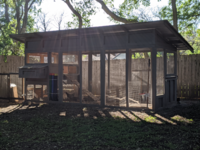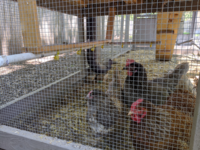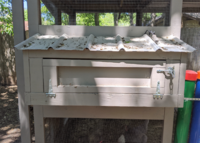Hi Everyone!
In 2019, my partner brought home 3 hens that a friend of hers needed to re-home. We knew we were going to have backyard chickens, but this sped up our plans. Our first coop was small and commercially manufactured. A neighbor was selling it. We knew it was temporary and started looking for larger options. We found Carolina Coops online and really liked the look and functionality of their designs. We didn't like their pricing, although we found that you do get what you pay for
After a month of staring down their designs, we gave our best shot at replicating a coop with some personal touches that were needed for our setup. We learned a lot by making a lot of mistakes and we're looking forward to building our next coop to incorporate the lessons we learned. Until then though, this will house 10-14 of our girls.
The design itself is fairly modular and built in 6' sections. The overall size is 6-8' high (sloping), 6' wide, and 18' deep. Primarily, it's composed of treated pine 2x4 lumber. It uses both 1/4" and 5/8" plywood for flooring and panels. All the connections are made with a Kreg Jig to give a little bit more refined look. I used 1/2" hardware cloth attached using 1/2" staples. Plywood was attached using 1 1/4" nail brads.
I clearly had no idea how to build a slanted roof and I've learned a lot from how poorly we did this one the next one will be great. Same goes for the dutch door. Yikes! But it's stable and lasted through many a storm.
the next one will be great. Same goes for the dutch door. Yikes! But it's stable and lasted through many a storm.
The hen house is fully vented on all four sides. During the Winter, we cover those areas to keep out the cold. We're in Texas, so we don't suffer the harsh winters. The run is fully enclosed and provides 9 sqft/bird. We also have a manual exit that leads out to "the Moat" which is a fenced (6' high) in area around the coop. It almost triples the square footage per hen.
I've added 4 'candy cane' style PVC feeding tubes filled with crumble or pellets. I've also added a rain barrel that drains into a gravity fed watering system with nipple-type stations (Not the same setup, but similar here). The last bit of work we're doing is creating a black soldier fly larva station for fresh grubs. We're just starting that now, so time will tell.
I'll update this with designs and materials list to download soon.
Tools used:
Air compressor
Pneumatic brad gun
Pneumatic stable gun
Table Saw
Miter Saw
Jig Saw
Hammer
Measuring Tape
Metal shears
Carpenter's square
Speed square
Stair gauge
Battery powered drill
Kreg Jig
Ladder
In 2019, my partner brought home 3 hens that a friend of hers needed to re-home. We knew we were going to have backyard chickens, but this sped up our plans. Our first coop was small and commercially manufactured. A neighbor was selling it. We knew it was temporary and started looking for larger options. We found Carolina Coops online and really liked the look and functionality of their designs. We didn't like their pricing, although we found that you do get what you pay for

After a month of staring down their designs, we gave our best shot at replicating a coop with some personal touches that were needed for our setup. We learned a lot by making a lot of mistakes and we're looking forward to building our next coop to incorporate the lessons we learned. Until then though, this will house 10-14 of our girls.
The design itself is fairly modular and built in 6' sections. The overall size is 6-8' high (sloping), 6' wide, and 18' deep. Primarily, it's composed of treated pine 2x4 lumber. It uses both 1/4" and 5/8" plywood for flooring and panels. All the connections are made with a Kreg Jig to give a little bit more refined look. I used 1/2" hardware cloth attached using 1/2" staples. Plywood was attached using 1 1/4" nail brads.
I clearly had no idea how to build a slanted roof and I've learned a lot from how poorly we did this one
 the next one will be great. Same goes for the dutch door. Yikes! But it's stable and lasted through many a storm.
the next one will be great. Same goes for the dutch door. Yikes! But it's stable and lasted through many a storm.The hen house is fully vented on all four sides. During the Winter, we cover those areas to keep out the cold. We're in Texas, so we don't suffer the harsh winters. The run is fully enclosed and provides 9 sqft/bird. We also have a manual exit that leads out to "the Moat" which is a fenced (6' high) in area around the coop. It almost triples the square footage per hen.
I've added 4 'candy cane' style PVC feeding tubes filled with crumble or pellets. I've also added a rain barrel that drains into a gravity fed watering system with nipple-type stations (Not the same setup, but similar here). The last bit of work we're doing is creating a black soldier fly larva station for fresh grubs. We're just starting that now, so time will tell.
I'll update this with designs and materials list to download soon.
Tools used:
Air compressor
Pneumatic brad gun
Pneumatic stable gun
Table Saw
Miter Saw
Jig Saw
Hammer
Measuring Tape
Metal shears
Carpenter's square
Speed square
Stair gauge
Battery powered drill
Kreg Jig
Ladder









